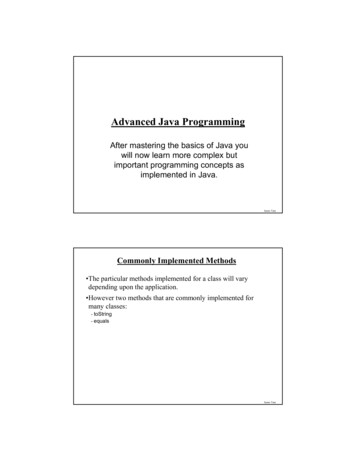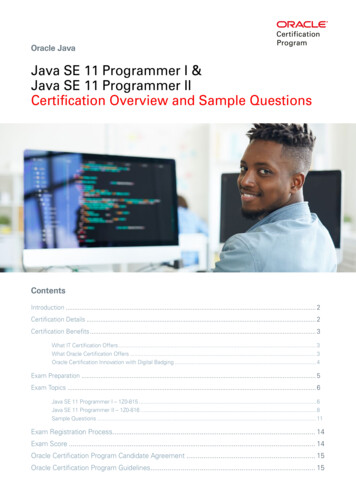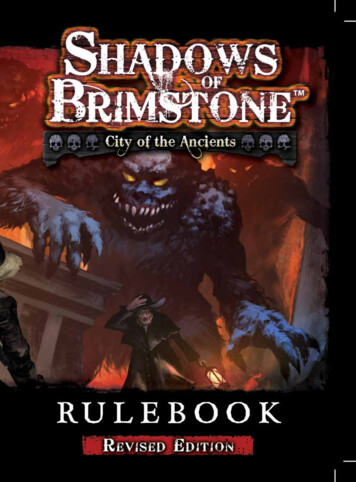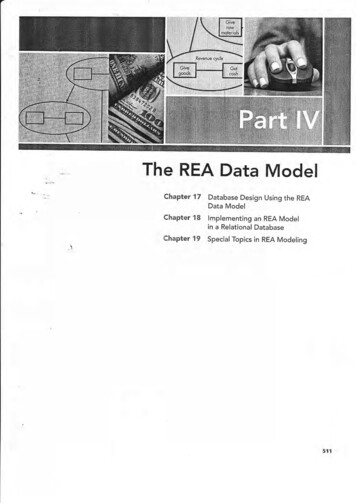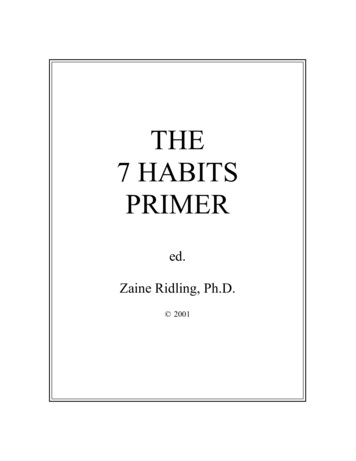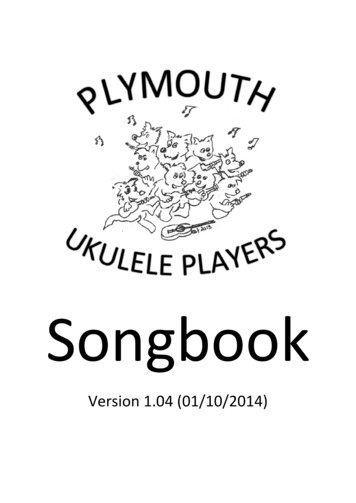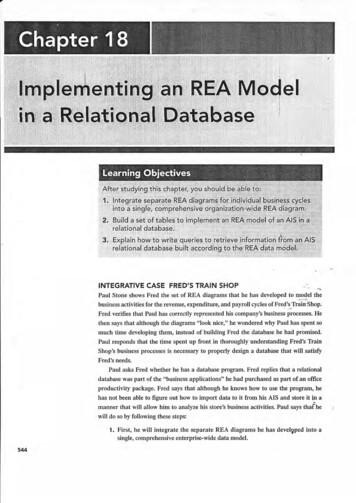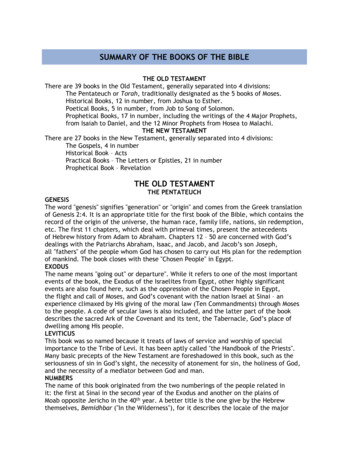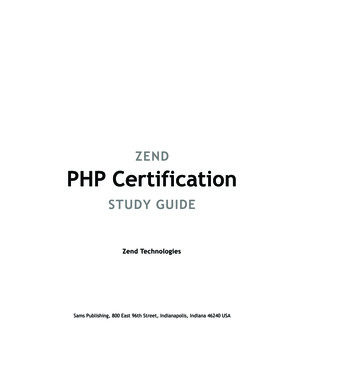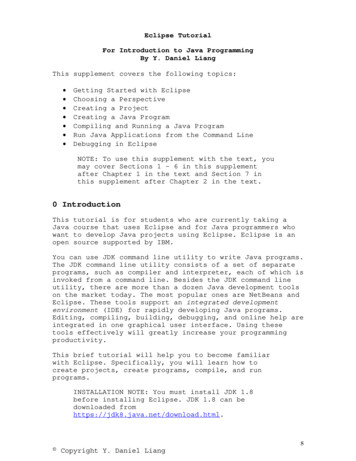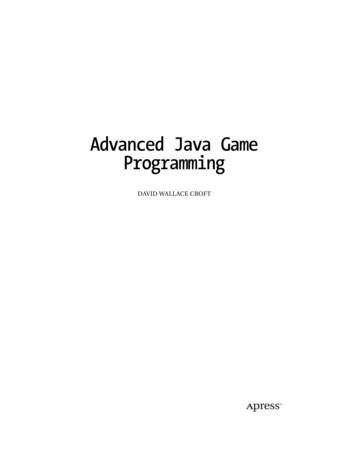
Transcription
1232fmfinal.qxd2/27/0411:50 AMPage iAdvanced Java GameProgrammingDAVID WALLACE CROFT
1232fmfinal.qxd2/27/0411:50 AMPage iiAdvanced Java Game ProgrammingCopyright 2004 by David Wallace CroftAll rights reserved. No part of this work may be reproduced or transmitted in any form or by anymeans, electronic or mechanical, including photocopying, recording, or by any informationstorage or retrieval system, without the prior written permission of the copyright owner and thepublisher.ISBN (pbk): 1-59059-123-2Printed and bound in the United States of America 10987654321Trademarked names may appear in this book. Rather than use a trademark symbol with everyoccurrence of a trademarked name, we use the names only in an editorial fashion and to thebenefit of the trademark owner, with no intention of infringement of the trademark.Lead Editor: Steve AnglinTechnical Reviewer: Jack ParkEditorial Board: Steve Anglin, Dan Appleman, Gary Cornell, James Cox, Tony Davis, JohnFranklin, Chris Mills, Steve Rycroft, Dominic Shakeshaft, Julian Skinner, Jim Sumser, KarenWatterson, Gavin Wray, John ZukowskiProject Manager: Sofia MarchantCopy Manager: Nicole LeClercProduction Manager: Kari BrooksProduction Editor: Ellie FountainCompositor: Gina Rexrode, Point n’ Click Publishing, LLCProofreader: Susannah PfalzerIndexer: Brenda MillerArtist: Kinetic Publishing Services, LLCCover Designer: Kurt KramesManufacturing Manager: Tom DebolskiDistributed to the book trade in the United States by Springer-Verlag New York, Inc., 175 FifthAvenue, New York, NY 10010 and outside the United States by Springer-Verlag GmbH & Co. KG,Tiergartenstr. 17, 69112 Heidelberg, Germany.In the United States: phone 1-800-SPRINGER, e-mail orders@springer-ny.com, or visithttp://www.springer-ny.com. Outside the United States: fax 49 6221 345229, e-mailorders@springer.de, or visit http://www.springer.de.For information on translations, please contact Apress directly at 2560 Ninth Street, Suite 219,Berkeley, CA 94710. Phone 510-549-5930, fax 510-549-5939, e-mail info@apress.com, or visithttp://www.apress.com.The information in this book is distributed on an “as is” basis, without warranty. Although everyprecaution has been taken in the preparation of this work, neither the author(s) nor Apress shallhave any liability to any person or entity with respect to any loss or damage caused or alleged tobe caused directly or indirectly by the information contained in this work.The source code for this book is available to readers at http://www.apress.com in theDownloads section.
1232ch01final.qxd2/27/0411:44 AMPage 1CHAPTER 1Development SetupA good example is the best sermon. —Benjamin FranklinIn this chapter, you will learn how to configure your development environmentto create your own games using the game library and examples described in thisbook.Upgrading to 1.4To compile and run the example games in this book, you need to download andinstall the Java 2 Software Development Kit (SDK), Standard Edition (J2SE), version 1.4 or later. “Java 2” refers to the Java 2 Platform. “Java 1.4” refers to thespecific version of the Java 2 Platform. You can blame the marketing folks at SunMicrosystems for the confusion.Version 1.4 is required because the game code depends upon new acceleratedgraphics classes in that version of the J2SE. These new classes greatly increase animation performance. At the time of this writing, J2SE v1.4 is available on multipleplatforms including Linux, Mac OS X, Solaris, and Windows. If you do not haveversion 1.4 or later installed, you can download it from http://java.sun.com/ forthe most common platforms besides Apple. Apple developers can download thelatest version of Java from http://developer.apple.com/java/.The game code should run without modification equally well on all platforms that support J2SE v1.4. Having said that, I must now warn you that I haveonly tested the code on Linux and Windows. I will depend upon the feedback ofreaders with Mac OS X and Solaris systems to let me know how the code fares onthose platforms.Sticking to the CoreThe J2SE defines a standardized application programming interface (API) librarywith thousands of classes grouped into scores of packages that are consideredcore. The core classes are guaranteed to be pre-installed on any J2SE-compatiblesystem. This makes the life of a developer much easier because it means lesscode that needs to be downloaded and installed to the client platform. Anexample of a core package is java.lang, which contains the basic classes neededin most Java programs.1
1232ch01final.qxd2/27/0411:44 AMPage 2Chapter 1Noncore classes are not guaranteed to be pre-installed on the target platform, so you will probably want to think twice before using them. Thesenon-core classes are known as optional packages. Until recently, they werecalled standard extensions. They are “extensions” in that they are not distributedwith the core, and they are “standard” in that they define standardized interfacesfor additional capabilities independent of their underlying implementation. Anexample of an optional package is javax.media.j3d, a library for rendering a 3Dscene graph.It used to be that you could easily tell which packages were core and whichwere standard extensions because the core package names all started with thejava prefix and the standard extension names all started with the javax prefix.This is no longer the case as the core now contains packages that start withnames other than java such as javax.swing. I am not sure why Sun Microsystemschanged this but I suspect it had something to do with the Microsoft lawsuit. Iknow that the switch continued to confuse even high-level Sun engineers forsome time after the decision was made. At some point they will have to give theJava library a complete overhaul. Perhaps they will call it the Java 3 Platform,Version 2.0. When they do so, I hope they consider changing the package namingconvention back to the way it was.Most of the example game code relies upon the core classes exclusively. Thisensures that they will run without additional installation steps on all J2SE platforms. A few of the games, however, do rely upon the optional packages. In thesecases, I will warn you.The subset of the J2SE for smaller platforms such as embedded devices isthe Java 2 Micro Edition (J2ME). The superset for heavy-duty platforms such asapplication servers is the Java 2 Enterprise Edition (J2EE). This book does notcover J2ME and only covers J2EE lightly. Where you need to use J2EE code, I willforewarn you just as I will when you use optional packages.Playing the Demo OnlineThe URL for the book web site is http://www.croftsoft.com/library/books/ajgp/.At that site, you can test the demonstration as pre-compiled and installed onlineto get a feel for what is available. From time to time, I will update the demo.Check the book web site for new releases and subscribe to the mailing list fornotifications of updates.The demo contains several animated Java programs including games andsimulations. You can scroll the tabs at the top of the screen to the left and rightto see the entire list. Of special interest is Sprite, a sprite animation test program.As shown in Figure 1-1, you can change the options and parameters to see thedifferent effects on animation performance.2
1232ch01final.qxd2/27/0411:44 AMPage 3Development SetupFigure 1-1. The Sprite demoExploring the Game LibraryYou can download a snapshot of the source code, graphics, and audio files forthe game library as a compressed archive file from the book web site. Thissnapshot of the code captures the version that is documented in this book.Post-publication archives might also be available. You can also download themost recent development version of the code by using a CVS client. Please seeAppendix B for more information.Once downloaded and decompressed, you can compile and run the example games from the source code. The following sections describe the directorystructure of the source code library.Directory croftsoftThe top-level directory within the archive is croftsoft/. It contains the mainbuild file, the readme.txt file, and the library subdirectories. The following listdescribes the subdirectory structure of the library in detail. Some of these subdirectories are not included in the zip archive but are created when you compilethe examples.3
1232ch01final.qxd2/27/0411:44 AMPage 4Chapter 1 arc/—packaged archives bin/—binaries and utilities doc/—javadoc documentation ext/—extension libraries lib/—compiled class library lic/—licenses res/—resource files src/—source code tmp/—temporary directoryDirectory arcThe executable Java archive (JAR) and web application archive (WAR) files areplaced in this directory when you package your code for distribution as part ofthe build process. Creating JAR files is described in greater detail in the nextchapter.Directory binThe bin/ subdirectory is a place for your development batch files, scripts, andutilities. My understanding is that bin is short for binaries. This is where youwould place your compiled binary utility files versus your source code text files. Icould be wrong about the origin of the name of the bin directory: It might simplystand for bin, a place to put things.path %path%;C:\home\croft\cvs\croftsoft\binYou want to append this directory to your path environment variable asshown in the preceding code. This directory contains the batch file javainit.batthat initializes your development environment. This is a useful batch file to runwhen you start working.4
1232ch01final.qxd2/27/0411:44 AMPage 5Development Setupsubst J: C:\home\croft\cvs\croftsoftsubst K: When working in Windows, I use this to substitute drive letter J: for my working directory. That way my other batch and build files are isolated from changes tothe name of my working directory because they use a path such as J:\src insteadof C:\home\croft\cvs\croftsoft\src. I use drive letter K: as a shortcut to the application source directory where I do most of my game development.You can also use javainit.bat to initialize environment variables you mightneed during the development process. On my machine, I have a number of environment variables defined for supplying applications and utilities with directorynames such as JAVA HOME, J2EE HOME, JBOSS HOME, and so on. Note that you do notneed to define any environment variables at this time to compile or run theexamples.javac -deprecation -d J:\lib -sourcepath J:\src -classpath J:\lib;[.] %1The bin/ directory also contains the batch file jc.bat which executes the preceding compile command. I have omitted some of the classpath values here tokeep it short. The %1 is the first argument to the command line and representsthe Java source code file name to be compiled. If you want to compile everythingin the current directory, you can just type in jc *.java.Directory docThe doc/ directory contains the javadoc documentation for your source code. Itis not a location for your manually created project documentation as you willwant to flush this directory occasionally to get rid of javadoc documentation fordeleted classes without fear that you might be getting rid of something that ishard to replace. Because the javadoc utility generates the contents of this directory automatically from the source code, you should not directly edit nor addthese files to version control.Directory extThe ext/ directory is a place for the optional package and extension library JARfiles that are required for your build. Before JAR files, developers used zip files toarchive classes so you occasionally see a .zip file name extension in this directory as well.-classpath J:\lib;J:\ext\j2ee.jar;J:\ext\javaws.jar;[.]5
1232ch01final.qxd2/27/0411:44 AMPage 6Chapter 1One of the reasons that I like to collect the extension JAR files in this directory instead of simply using them where they were installed originally is that itmakes for a more readable classpath. I would rather use a short argument suchas J:\ext\javaws.jar instead of a long one such as C:\Program Files\Java WebStart\javaws.jar. Also, sometimes space characters in a directory name such asProgram Files confuse applications that use it in the classpath.Finally, and probably most importantly, is that it consolidates all of yourextension libraries for your project where it is easy to put them under versioncontrol. It seems a bit odd to put a third-party binary file under version controlwhen you can usually just download another copy from the third-party web sitewhenever you need it. This is unreliable, however, as there might be dependencies in the code that require you to use an older version of a library that is nolonger distributed from the vendor site. When your ext/ directory is under version control, you have a snapshot of the versions of all the different extensionlibraries that are known to work reliably with your project. It also makes it easieron your fellow developers, including you if you ever need to move to anotherdevelopment machine. You can pull the JAR files from the version control systeminstead of downloading them all over again from multiple vendor web sites.Directory libThe lib/ directory is the destination directory for your compiled Java classes:The files that end with the .class file name extension. This is the -classpathargument to your javac compile command and the -cp argument to the javaexecution command.The abbreviation lib stands for library. Keep in mind, however, that thisdirectory is only for the compiled counterparts to the source code files in thesrc/ directory. You should keep your third-party libraries in a different directorysuch as ext/ as you want to be able to flush the lib/ directory to get rid of outdated versions of the compiled classes without fear that you will be deletingsomething hard to replace. Because all the files in the lib/ directory are derivedfrom the src/ directory, there is no reason to place them under version control.Directory licThe lic/ directory contains copies of the Open Source software licenses. This isdescribed in more detail later in this chapter.6
1232ch01final.qxd2/27/0411:44 AMPage 7Development SetupDirectory resYou use the res/ directory to keep the resource files you need to complete yourbuild separate from the Java source code files. It includes JAR manifests, WARconfiguration files, multimedia resources such as audio and graphics, and staticdata files.Each source code file has an appropriate position within the src/ directoryhierarchy based upon its package prefix. This is not true with other types of filesused in the build. Rather than putting those files in the src/ root directory orsomewhere below, such as a directory that corresponds to the package that contains the main class for the application, I just keep them in a separate directoryaltogether, the res/ directory.Directory srcThe src/ directory contains the uncompiled Java source code: the files with the.java file name extension. This is also a place for your Hypertext MarkupLanguage (HTML) javadoc descriptions. The javadoc utility looks for the filepackage.html in each directory in the source path and assumes it contains adescription of the classes in the package that corresponds to the directory level.Directory tmpThe tmp/ directory is created during the build process to hold working files temporarily. The directory is usually destroyed when the build ends. If your build isinterrupted due to a compile error, this directory might not get removed. It doesnot hurt to leave this directory in existence if you find it, as the next successfulbuild first deletes it automatically, creates it anew, then deletes it again. If you dodecide to delete it manually, the only restriction is that you do not do it while abuild is running.Introducing XMLTo build, package, and deploy your games, you need to understand the basics ofExtensible Markup Language (XML). XML is also useful for storing game dataand user preferences on the hard drive and passing multi-player messages overthe network. This section introduces XML briefly.XML allows you to describe data using human-readable text. In the following example, note how each data value is encapsulated in an opening andclosing element tag pair that names the data field.7
1232ch01final.qxd2/27/0411:44 AMPage 8Chapter 1 book title Advanced Java Game Programming /title author David Wallace Croft /author publisher Apress /publisher pubdate 2004 /pubdate /book Those familiar with HTML will recognize the similarities. It looks like HTMLexcept that I have created my own element names such as book and title. HTMLalready defines the element title, but here I have given it a new semantic, ormeaning, that differs within the context of my book definition. Indeed, this abilityto define new elements is why XML is considered “extensible.”Despite the flexibility in being able to define new element names, there areenough constraints in the XML format that parsers do not need to be customizeduniquely for each definition. Such restrictions include a strict hierarchical nestingof elements. For example, the following XML syntax with overlapping tag boundaries would generate a parsing error. b i Illegal XML /b /i Although the preceding code might be valid in HTML, the proper way tonest the elements in Extensible Hypertext Markup Language (XHTML)—a definition of XML that replaces HTML—would be as follows. i b Legal XML /b /i Hundreds, perhaps thousands, of XML definitions now cover everythingfrom genealogy to electronic commerce. Wherever data needs to be exchangedin a transparent manner using standard parsers that are readily available in allthe major programming languages, XML provides a solution.Further information on the subject of XML is easily accessible from a largenumber of sources as XML has rapidly become a widely adopted technology. Asa quickly digestible introduction and handy reference book, I recommend theXML Pocket Reference, 2nd edition by Robert Eckstein (O’Reilly & Associates,2001).Compiling with AntAnt is the Open Source tool that you will use for compiling the example gamesource code. Ant is more powerful than older tools such as make as it is extensibleand cross-platform. Although some warn against it, you might want to considerusing Ant as a universal scripting language to replace your platform-specific8
1232ch01final.qxd2/27/0411:44 AMPage 9Development Setupbatch or script files. If it lacks a function you need, Ant happily allows you tointegrate any Java code you want to write to increase its capabilities.Ant is distributed from the Apache Jakarta Project web site and has gainedrapid and almost universal acceptance by the Java community. If you have notalready learned how to use Ant, you should consider doing so. You can start byreading the online documentation at http://ant.apache.org/. project name "myproject" default "compile" target name "compile" [.] /target target name "archive" depends "compile" [.] /target /project Ant takes its instructions on how to compile the source code from an XMLbuild file with a default name of build.xml. A build file is organized as a projectwith multiple targets. Each target contains zero or more tasks that are the commands executed by the Ant processor.The tasks in a target are usually related in a set that might depend upon thesuccessful completion of one or more previous targets. For example, I mighthave a target called archive that archives the latest version of my source codeand moves it to a backup directory. The archive target might depend uponanother target called compile that attempts to compile the entire library. If I runAnt on my project build file with the target archive specified as a command-lineargument, Ant first attempts to run the compile target. If that step fails, it terminates operations without proceeding to archive.You can compile and run most of the example game source code by runningAnt on the build.xml file in the library root directory using the default target. Thefollowing is a line-by-line review of the first part of the file that you use to buildthe main demonstration program. This is the build code that you could adapt tocompile and package your own games. project name "croftsoft" default "demo" If this build file is executed without specifying a target as a command-lineargument, Ant assumes the default demo target. property name "arc dir" value "arc"/ property name "res dir" value "res"/ property name "src dir" value "src"/ property name "tmp dir" value "tmp"/ 9
1232ch01final.qxd2/27/0411:44 AMPage 10Chapter 1To prevent the directory names from being hard-coded in the rest of thebuild file, define them here using property variables. Once a property value isdefined, it cannot be redefined later in the build file. You might need to adjustthese directory names to match your own preference. target name "init" mkdirdir " {arc dir}"/ delete dir " {tmp dir}"/ mkdirdir " {tmp dir}"/ tstamp format property "TODAY ISO" pattern "yyyy-MM-dd"/ format property "YEAR"pattern "yyyy"/ /tstamp /target The default target demo indirectly depends on target init so I will review theinit target first. It starts by creating the output and temporary working directories. If the output directory arc dir already exists, the build file presses onwithout throwing an error. The temporary directory is re-created to make sureno old files are left behind from a previous build attempt.Task tstamp sets a property called TODAY ISO to a value representing thecurrent date in International Standards Organization (ISO) format such as1999-12-31. Some of the following targets use this property to append thedate to archive file names. target name "shooter prep" depends "init" copy todir " {tmp dir}/media/shooter" fileset dir " {res dir}/apps/shooter/media" include name "shooter bang.png"/ include name "shooter boom.png"/ include name "shooter rest.png"/ include name "bang.wav"/ include name "explode.wav"/ /fileset /copy /target In preparation for compiling the demo, the resource files for a game arecopied from the resource directory to the temporary working directory. The preceding code demonstrates a variant of the copy command that uses a fileset.Rather than issue a separate copy command for each file, you use the fileset tagto copy all the files to the temporary working directory in a single command. Youcan also use wildcards and pattern matching to describe the files to include in a10
1232ch01final.qxd2/27/0411:44 AMPage 11Development Setupfileset. I like to specify the files individually by name so that I know exactlywhat is being packaged. target name "collection prep1"depends "basics prep,dodger prep,fraction prep,mars prep"/ target name "collection prep2"depends "road prep,shooter prep,sprite prep,tile prep,zombie prep"/ target name "collection prepare"depends "collection prep1,collection prep2" copy file " {res dir}/apps/images/croftsoft.png"todir " {tmp dir}/images"/ /target Target collection prepare depends on collection prep1 and collection prep2.I break it up this way so that the depends tag value does not run too long. The purpose of collection prepare is to copy all the resource files for the individual gamesthat go into the CroftSoft Collection into the temporary working directory. It alsocopies any additional resource files, such as croftsoft.png, which you use for theframe icon. target name "collection compile" depends "collection prepare" javac srcdir " {src dir}" destdir " {tmp dir}" includename .java"/ include name "com/croftsoft/ajgp/basics/BasicsExample.java"/ [.] include name "com/croftsoft/apps/zombie/Zombie.java"/ /javac /target You use the javac task to compile the source code in the src dir directoryand output the compiled class files to tmp dir. Normally you would only need toinclude the main class and javac would be smart enough to compile all the otherclasses that are required. In this case, however, the individual game applets arelinked dynamically instead of statically and you must also name them explicitly.This is described further in the next chapter.11
1232ch01final.qxd2/27/0411:44 AMPage 12Chapter 1 target name "collection jar" depends "collection compile" echofile "manifest.txt" message "Main-Class: com.croftsoft.apps.collection.CroftSoftCollection" / jarbasedir " {tmp dir}"destfile " {arc dir}/collection.jar"manifest "manifest.txt"update "false"/ delete file "manifest.txt"/ delete dir " {tmp dir}"/ /target target name "demo" depends "collection jar" java fork "true" jar " {arc dir}/collection.jar"/ /target If the collection compile target compiles successfully, the collection jartarget executes. The collection jar target packages the temporary workingdirectory contents, which include compiled code and resource files. It overwritesthe old JAR file if it exists in the output arc dir directory. When completed, thetemporary directory is deleted and the newly created executable JAR is launchedin a separate Java Virtual Machine (JVM) for testing.The rest of the build file contains additional targets that compile demonstrations and examples that require optional packages beyond what the core J2SElibrary includes. A quick review of the comments embedded in the build file willtell you what optional packages are required to compile and run some of theadditional example games not included in the default demo target. You can safelyignore these other targets for now as I will cover them in later chapters of thebook.ant basicsIf Ant is properly installed, you should simply be able to enter the commandant in the directory containing the build.xml file and the default demo target willcompile and launch. If you want to specify a different target, you simply provideit as a command-line argument as shown in the preceding code. Target basics,for example, builds and launches an example game described at the end of thischapter. If you have not already done so, go ahead and build and run the demousing Ant and the example build file.12
1232ch01final.qxd2/27/0411:44 AMPage 13Development SetupUsing Open SourceHopefully by this point you have been able to compile and run the demonstration program successfully and are now ready to learn how to modify andincorporate the code library as described in the book to create your own games.Before you get too invested in the library, however, you should know the usagelimitations and requirements.Learning the Basics of CopyrightCopyright used to be a mystery to me until I did a little reading on the subject.Here are a few key basics I think every developer should know. You do not need to put a copyright statement on your work nor file paperwork for it to be copyrighted. It is copyrighted automatically by the simpleact of creation. Putting the copyright statement on your work and registering your copyright does help you when it comes to receiving damageawards for copyright infringement. You no longer need to append “All rights reserved” to your copyright statement. The law changed and it is now assumed. If you are an employee, your employer is the copyright holder of worksyou create on the job by default. If you are an independent contractor, youare the copyright holder by default unless your contract states otherwise.Your contract almost always states otherwise unless you drafted the contract yourself. If you create a work with someone else, then you both own the copyrightjointly unless an agreement states otherwise. Use and distributionrequires unanimous consent and you must share profits from such a work. It is possible to create a contract where the work is owned jointly withoutaccountability. In this case, each copyright holder can use the work without accounting to the other. It is as though they each own the copyrightindependently and do not need to share profits or seek mutual permission. This might be a useful arrangement if you are teaming with others tocreate a game for your portfolio instead of for profit. A copyright holder has the exclusive right to use, distribute, and modifythe work. If you create a work that incorporates a work by someone else,either in whole or in part, you have created a derivative work. You musthave the permission of the copyright holder of the original work in orderto create a derivative work legally.13
1232ch01final.qxd2/27/0411:44 AMPage 14Chapter 1 Copyright law makes an exception for fair use of a work. This means thatunder certain circumstances you can use a work without the permissionof the copyright holder. This is limited to just a few enumerated uses suchas parody, teaching, critical review, and news. There are land mines in theFair Use doctrine so beware. In general, you should not rely upon Fair Useto incorporate material into your game. Works created by the government are not entitled to copyright. This iswhy the space pictures taken by NASA are in the Public Domain. If youare creating a science fiction game that requires images of stars, planets,space shuttles, rockets, and astronauts, you are in luck. See http://gimpsavvy.com/PHOTO-ARCHIVE/ for a collection of Public Domain space photosyou can use in your games. A license is a grant of permission by a copyright holder to use a work.Licenses come in all shapes and sizes. Some are exclusive, meaning thatthe licensee is the only one who can use the work, and some are nonexclusive, meaning that many can use the work simultaneously. If yougrant an exclusive license to your game to someone for a limited time, youretain the copyright but you cannot allow someone else to use the gameduring that period. A common misperception is that if something is on the Web and it doesnot have a copyright statement on it, it is in the Public Domain and can beused without permission and without attribution. This is simply wrong
to create your own games using the game library and examples described in this book. Upgrading to 1.4 To compile and run the example games in this book, you need to download and install the Java 2 Software Development Kit (SDK), Standard Edition (J2SE), ver-sion 1.4 or later. “Java 2” refers to the Java
